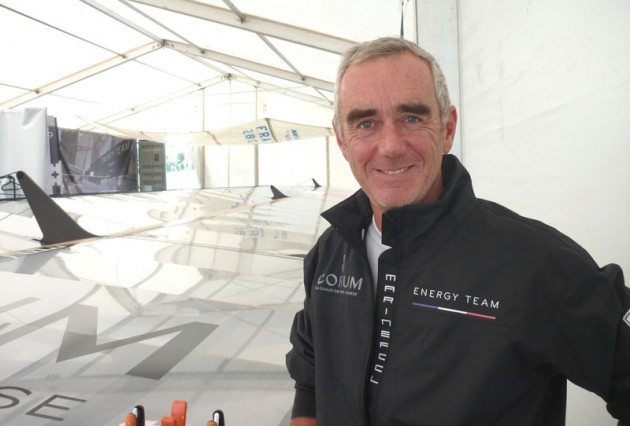Loick Peyron explains why he thinks wingmasts underpin a new America's Cup appeal
Critics of the America’s Cup’s change to multihulls should revise their opinion after a spectacular weekend of hair-raising racing at the World Series in Plymouth that thrilled the public.
The success of the event in bright and blustery conditions on Sunday has surpassed the expectations of even those who have long advocated multihull racing. Even the greatest of these champions, French sailor Loick Peyron, is surprised by what’s being demonstrated in Plymouth.
“The wingmast is the thing that will change the game,” he declares. “It is a great discovery. It’s the start of a new era.”
Although he’s been a multihull maestro for 30 years, Peyron had never sailed with a wingmast until just before the AC World Series in Cascais in August. He is the skipper of French entry Energy Team.
“To be frank, when Russell [Coutts] showed us the first drawings of the boat a year ago I said ‘Why a wingmast? It will be a mess in terms of logistics and cranes.’ I was wrong.”
The wingmast is one of the chief ingredients of the close racing being showcased here, something many critics believed multihulls would not offer. Many believed the fleet would spread out and fail to generate much boat-on-boat combat. Peyron points out that wingmasts narrow the gap.
“In the past, with soft sails, multihulls were difficult to tack because they are so light and they have a lot of drag, but the wingmasts have a lot less drag and that is a really impressive thing,” explains Peyron.
“With the wing it’s no problem to go through the wind and you can stop and start again very quickly. So that’s very interesting for racing, especially match racing, because you have enough momentum for dial-ups and the boats are a bit more manoeuvrable.”
Like all the skippers here, Peyron is learning how to handle his boat. He says that he’s happy to be one of the few remaining members of the “non-capsize club”, but he did come very close yesterday after burying the bows of his boat on a bear away.
“Obviously with a wingmast you have the same amount of power whatever the wind, and unlike a soft sail you cannot reduce it. You can play with camber and profile but you still have the same height. Although it’s very controllable there’s a certain angle when you can’t escape,” he explains.
“If you have an apparent wind angle of 80-110° you can come up, but after that is a tricky area where there’s not much escape – you bear away, the apparent wind speed increases and it’s like having an engine with hundreds of horsepower and the accelerator fully down.
“Because the wingmast is heavier and the centre of gravity is higher [than an equivalent soft sail], the wing pushes you over to the death limit.
“But if the wind can capsize you it can also save you, because when you are capsizing and you ease the traveller the wind underneath the wing acts like an aeroplane’s wing and pushes you up.”
Another thing we are learning with anticipating the bear away,” he continues, “is how to use the daggerboards. You can trip over them so every time you make your last tack on the lay line to the windward mark you have to lift the board a little. You lose a little, of course, but then you can be sure to get a smooth bear away.”
Peyron is a great fan of the reaching starts being used here. “There are a lot of tactics and different ways of defending your place, and it’s much better than a slow start, which is more about blocking,” he comment.
“The great thing is that the starts are so fast and impressive and you never know who is going to win the first rounding, which can be in 25 seconds.
“The America’s Cup is a product that needs to be attractive,” he adds, “and a reaching start is very attractive.”
The subject of capsizes and how to manage them is another lesson being learned and shared by teams today. When laid in the water the top of the masts fill with water and this weekend teams that capsized discovered that when they were righted by RIBs the weight of water cascading down through the wingmasts can break the carbon and Nomex ribs that form part of their structure.
The suggested solution is a technique for support crews to pull the rigs out of the water and allow the water to empty before righting completely.
Green Comm learned a lesson that has been well observed here, too. Watch the videos from yesterday and you’ll see them perform a spectacular double capsize, recovering from one only to bounce straight into another on the other hand.
“They capsized with too much camber [between the wingmast and the flaps] and forgot to ease the control line.” Loick Peyron explained to me. “So when the boat righted it caught the wind, powered up and capsized again.”
This week’s racing and preparations offer a chance to see some of these technical and handling lessons being learned first hand. There is no racing tomorrow, but some of the teams are planning to crane in boats and rigs from about 1100, providing another opportunity to see up close how this intricate and fascinating show is put on the road.




